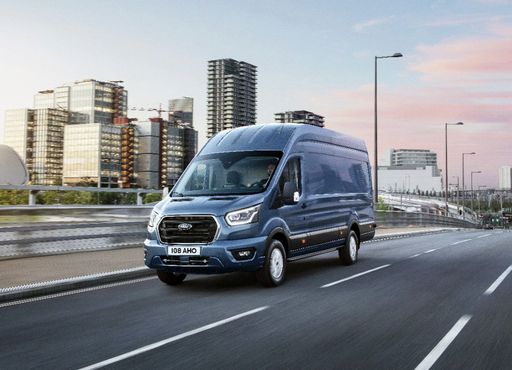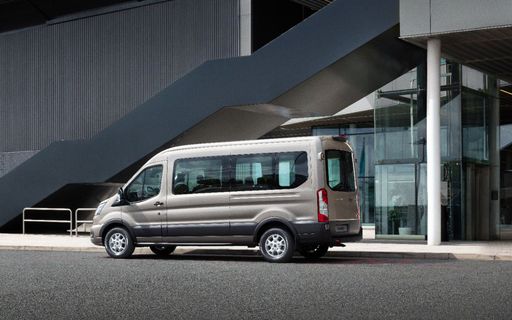When it comes to selecting the right transporter for commercial use, the options are numerous, but two standouts in the market today are the Ford Transit Custom Transporter and the Toyota Proace Bus. Each vehicle brings unique technical aspects, innovations, and features that appeal to different business needs. In this comparison, we will highlight their key specifications, performance capabilities, and advanced technologies.
Ford Transit Custom Transporter vs Toyota Proace Bus – Który samochód bardziej do Ciebie pasuje?
Porównaj osiągi, bagażnik, zużycie i cenę jednym rzutem oka.
Sprawdź, który samochód będzie dla Ciebie lepszym wyborem – Ford Transit Custom Transporter czy Toyota Proace Bus?
Ford Transit Custom Transporter: Versatility and Power
The Ford Transit Custom Transporter is designed for businesses in need of a reliable and adaptable cargo van. With an array of engine options, including Electric, Diesel, and Plugin Hybrid variants, the Transit Custom offers flexibility for different working environments. This model allows the integration of environmentally-conscious technologies without sacrificing power.
Engine choices range from 110 HP up to a robust 286 HP, offering substantial torque with figures reaching 415 Nm. The model also features diverse drive types, including Rear-Wheel Drive, Front-Wheel Drive, and All-Wheel Drive, catering to varying driving conditions.
Performance and Efficiency
In terms of fuel consumption, the Transit Custom excels with an efficient rate as low as 1.6 L/100km for diesel options and an electric consumption rate from 22.4 kWh/100km. The electric variants boast impressive ranges of up to 327 km, ideal for city-based operational duties.
From a comfort standpoint, seating configurations for the Transit Custom range between 3 to 6, making it suitable for a variety of passenger or cargo needs. With a maximum payload capacity of 1332 kg, businesses can rely on it for heavy-duty operations.
Innovative Features
Ford has packed the Transit Custom with innovative technology, such as Ford's SYNC 3 infotainment system, providing seamless connectivity and navigation options. Safety features include automated braking systems and adaptive cruise control, which enhance driving security and ease.
Toyota Proace Bus: Comfort and Functionality
The Toyota Proace Bus focuses on passenger comfort while delivering practical functionality, making it a preferred choice for transfer services or shuttle operations. With body types designed specifically for passenger transport, it offers seating configurations for up to 9 people.
Similar to the Transit, the Proace comes equipped with both Electric and Diesel engines, but with power outputs ranging from 136 to 177 HP. The drive type is limited to Front-Wheel Drive, which contributes to a smoother ride, particularly when navigating urban environments.
Fuel Efficiency and Performance
The Proace Bus boasts competitive fuel consumption figures, achieving as low as 7.3 L/100km for diesel engines and 24.2 kWh/100km for electric drives. Its electric range caps at 343 km, providing considerable distance for logistics operations. The maximum speed reaches up to 170 km/h, with acceleration times around 13.3 seconds for 0-100 km/h.
Payload and Safety Innovations
In terms of payload, the Proace Bus has a carrying capacity of up to 1265 kg. This makes it highly functional for transporting goods or multiple passengers without compromising safety or comfort. Additionally, it is equipped with modern safety features including standard airbags and advanced electronic stability control systems.
Conclusion: Choosing the Right Fit
Both the Ford Transit Custom Transporter and the Toyota Proace Bus represent two exceptional options in the market of transport vehicles. The choice ultimately hinges on the specific needs of your business. If versatility, power, and technological innovation are your priorities, the Ford Transit Custom may be the better fit. Conversely, for comfort and functionality in passenger transport, the Toyota Proace Bus offers an impressive package.
In conclusion, whether you're hauling cargo or ensuring a smooth ride for passengers, both the Ford Transit Custom Transporter and the Toyota Proace Bus deliver robust performance blended with modern features, making either a worthy contender in the commercial vehicle arena.
Szczegóły techniczne: konkretne różnice między modelami
Koszty i zużycie
Cena zakupu i efektywność to często pierwsze kryteria przy wyborze auta. Tutaj widać, który model lepiej wypada w dłuższej perspektywie – przy tankowaniu, ładowaniu lub zakupie.
Toyota Proace Bus ma lekko przewagę cenową – jego cena zaczyna się od 161800 zł, podczas gdy Ford Transit Custom Transporter kosztuje 185800 zł. Różnica wynosi około 24073 zł.
Pod względem zużycia energii przewagę ma Ford Transit Custom Transporter: z wynikiem 22.40 kWh na 100 km jest prawie niezauważalny bardziej wydajny niż Toyota Proace Bus, który zużywa 24.20 kWh. Różnica to około 1.80 kWh.
Pod względem zasięgu Toyota Proace Bus wypada ledwo zauważalny lepiej: osiąga do 343 km, czyli około 16 km więcej niż Ford Transit Custom Transporter.
Silnik i osiągi
Pod maską widać, który model jest bardziej sportowy i kto ma lepszy start.
Pod względem mocy silnika Ford Transit Custom Transporter ma oczywisty przewagę – 286 KM zamiast 177 KM. To różnica około 109 KM KM.
W przyspieszeniu 0–100 km/h Toyota Proace Bus jest niewielki szybszy – 13.30 s wobec 13.40 s. Różnica wynosi około 0.10 s sekundy.
Pod względem prędkości maksymalnej Toyota Proace Bus jest lekko lepszy – osiąga 170 km/h, podczas gdy Ford Transit Custom Transporter kończy na 150 km/h. Różnica to około 20 km/h.
Różnica widoczna jest również w momencie obrotowym: Ford Transit Custom Transporter ciągnie prawie niezauważalny mocniej – 415 Nm wobec 400 Nm. Różnica to około 15 Nm.
Przestrzeń i praktyczność
Poza mocą liczy się też wygoda i funkcjonalność. Tu decyduje się, który samochód jest bardziej praktyczny i wszechstronny.
Miejsca siedzące: Toyota Proace Bus oferuje oczywisty więcej miejsc – 9 vs 6.
Pod względem masy własnej Toyota Proace Bus jest prawie niezauważalny lżejszy – 1835 kg wobec 1893 kg. Różnica to około 58 kg kg.
Pod względem ładowności Ford Transit Custom Transporter wypada niewielki lepiej – 1332 kg wobec 1265 kg. Różnica to około 67 kg kg.
Kto wygrywa pojedynek?
Ford Transit Custom Transporter okazał się wygrywa niewielką różnicą i tym samym zdobywa tytuł DriveDuel Champion!
W tym porównaniu Ford Transit Custom Transporter to bardziej wszechstronny wybór.

Ford Transit Custom Transporter
Ford Transit Custom Transporter
Ford Transit Custom Transporter to wszechstronny pojazd zaprojektowany z myślą o profesjonalnych użytkownikach. Jego przestronne wnętrze oraz inteligentne rozwiązania sprawiają, że transport ładunków staje się wyjątkowo komfortowy i efektywny. W połączeniu z nowoczesnym designem, Transit Custom Transporter to idealny wybór dla firm poszukujących niezawodności i stylu.
szczegóły @ media.ford.com
@ media.ford.com
 @ media.ford.com
@ media.ford.com
 @ media.ford.com
@ media.ford.com
Toyota Proace Bus
Proace Bus to wszechstronny van, który idealnie sprawdza się w transportach osób. Dzięki przestronnemu wnętrzu i komfortowym siedzeniom, podróżowanie staje się przyjemnością, niezależnie od odległości. Model ten łączy elegancję z funkcjonalnością, co czyni go doskonałym wyborem dla rodzin oraz firm cateringowych.
szczegóły

|
|
|
|
|
Koszty i Zużycie |
|
|---|---|
|
Cena
185800 - 364600 zł
|
Cena
161800 - 316900 zł
|
|
Zużycie L/100km
-
|
Zużycie L/100km
7.3 - 7.4 L
|
|
Zużycie kWh/100km
22.4 - 24.1 kWh
|
Zużycie kWh/100km
24.2 - 24.4 kWh
|
|
Zasięg elektryczny
315 - 327 km
|
Zasięg elektryczny
218 - 343 km
|
|
Pojemność baterii
11.8 - 64 kWh
|
Pojemność baterii
-
|
|
CO2
0 g/km
|
CO2
0 - 193 g/km
|
|
Pojemność zbiornika paliwa
55 - 63 L
|
Pojemność zbiornika paliwa
69 L
|
Wymiary i Nadwozie |
|
|---|---|
|
Typ nadwozia
Van
|
Typ nadwozia
Bus
|
|
Miejsca siedzące
3 - 6
|
Miejsca siedzące
5 - 9
|
|
Drzwi
4
|
Drzwi
4 - 5
|
|
Masa własna
1893 - 2122 kg
|
Masa własna
1835 - 2140 kg
|
|
Pojemność bagażnika
-
|
Pojemność bagażnika
0 L
|
|
Długość
5050 - 5450 mm
|
Długość
4983 - 5333 mm
|
|
Szerokość
2032 mm
|
Szerokość
1920 mm
|
|
Wysokość
1958 - 1959 mm
|
Wysokość
1890 mm
|
|
Maksymalna pojemność bagażnika
5800 - 6800 L
|
Maksymalna pojemność bagażnika
-
|
|
Ładowność
802 - 1332 kg
|
Ładowność
825 - 1265 kg
|
Silnik i Wydajność |
|
|---|---|
|
Typ silnika
Elektryczny, Diesel, Hybryda Plug-in
|
Typ silnika
Elektryczny, Diesel
|
|
Skrzynia biegów
Automatyczna, Manuel
|
Skrzynia biegów
Automatyczna, Manuel
|
|
Szczegóły skrzyni biegów
Reduktor, Manualna skrzynia biegów, Automatyczna skrzynia biegów, Skrzynia CVT
|
Szczegóły skrzyni biegów
Reduktor, Manualna skrzynia biegów, Automatyczna skrzynia biegów
|
|
Rodzaj napędu
Napęd na tylne koła, Napęd na przednie koła, Napęd na cztery koła
|
Rodzaj napędu
Napęd na przednie koła
|
|
Moc KM
110 - 286 KM
|
Moc KM
136 - 177 KM
|
|
Przyspieszenie 0-100km/h
13.4 - 16.9 s
|
Przyspieszenie 0-100km/h
13.30 s
|
|
Maksymalna prędkość
110 - 150 km/h
|
Maksymalna prędkość
130 - 170 km/h
|
|
Moment obrotowy
310 - 415 Nm
|
Moment obrotowy
260 - 400 Nm
|
|
Liczba cylindrów
4
|
Liczba cylindrów
4
|
|
Moc kW
81 - 210 kW
|
Moc kW
100 - 130 kW
|
|
Pojemność silnika
1996 - 2488 cm3
|
Pojemność silnika
1997 cm3
|
Ogólne |
|
|---|---|
|
Rok modelowy
2023 - 2024
|
Rok modelowy
2024 - 2025
|
|
Klasa efektywności CO2
A
|
Klasa efektywności CO2
A, G
|
|
Marka
Ford
|
Marka
Toyota
|
Jakie rodzaje napędu ma Ford Transit Custom Transporter?
Ford Transit Custom Transporter jest dostępny z napędem Napęd na tylne koła, Napęd na przednie koła albo Napęd na cztery koła.
Wyświetlane ceny i dane są szacunkowe, oparte na niemieckich cenach katalogowych i mogą się różnić w zależności od kraju. Te informacje nie stanowią wiążącej oferty.
